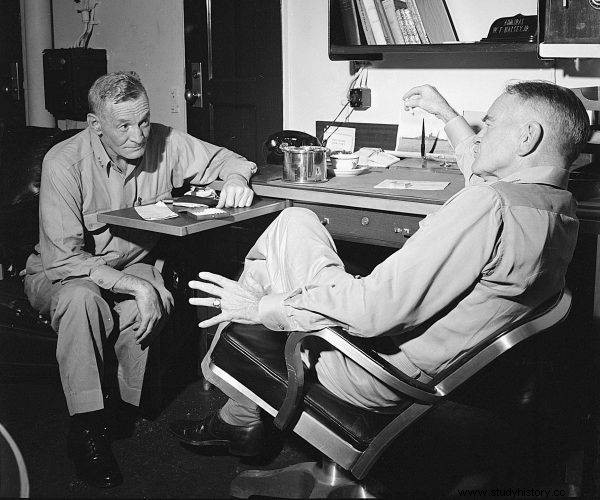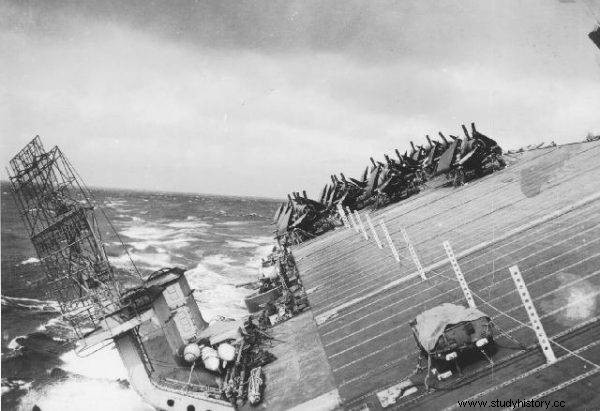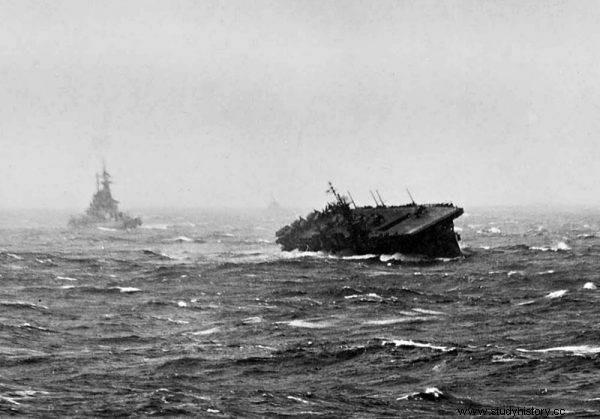Wind blowing at a speed of 240 km / hour, waves with a height of 15 meters and rain peeling the skin from the face - such a cataclysm fell on December 18, 1944 on the American fleet operating in the Philippines. A powerful tropical typhoon chased Admiral Halsey's ships out. Three destroyers sank, 25 units were damaged. Almost 800 sailors were killed…
Many times in history the weather has been a determining factor in a victory or a defeat in a war. For example, Napoleon, whose invincible army was chased away from Moscow by the most difficult opponent - "General Mróz", was convinced of this. They do not ignore weather conditions and their influence on hostilities in Japan.
Most of us are familiar with the word "kamikaze". It became popular during World War II due to suicide pilots crashing on American ships. However, its origin is much older - it means "divine wind" blowing on the doom of the barbarian invaders. "Kamikaze" are typhoons which twice (in 1274 and 1281) destroyed the Mongol invasion fleets heading towards the Japanese Islands. The Japanese took it as evidence of divine protection over their country.
During World War II, the prayers of Japanese mothers brought back "divine wind." This time it took the form of a tropical typhoon that swept over the group of ships of Admiral William Halsey. Although this typhoon could not be decisive for the fate of the war, it caused huge losses - much more than in the American-Japanese battles fought on the ocean at that time. Even greater than those caused by attacks by suicide pilots!
Halsey is not afraid of the rain
Typhoon season in the South Pacific runs from May to December, so it was not surprising that on December 16, 1944, American weather stations detected a "tropical weather anomaly" on radar. It was heading towards the fast strike formation commanded by Admiral Halsey called "Task Force 38". It was a massive group of ships that was just returning from the bombing of Japanese airfields on the island of Mindoro in the Philippines.
Halsey had 7 aircraft carriers, 6 light aircraft carriers, 8 battleships, 15 cruisers and approximately 50 (!) destroyers under arms. The crews of all units were ordered to prepare for the storm. But what strength? Lieutenant Commander George F. Kosco, the weather expert on the USS New Jersey, Halsey's flagship, hadn't expected anything out of the ordinary and didn't panic. For Halsey, on the other hand, the priority was to refuel so that his group would regain full combat efficiency and could attack the enemy again. Craig Symonds in his book "World War II at Sea" writes:
Halsey was not the type of man to be scared off by bad weather, but since some of his destroyers had only 15 percent fuel in their tanks - which was already a dangerous level - he decided to go on a scheduled refueling . To avoid the storm, he moved the meeting point nearly 300 kilometers further south. He did not know that in this way he would be heading directly towards the impending storm that grew stronger .

Halsey (right) was not the type of person to be scared off by bad weather
Meanwhile, it was not a storm that was headed towards Halsey's team, but typhoon - the 23rd and last of the season. As it turned out, stronger than all the previous ones. Theoretically, powerful aircraft carriers could not be harmed, but with small destroyers it was different. There was an echo in their empty tanks, making the ships light and bouncing on the waves like inflatable wheels of beach-goers in Międzyzdroje. It was Halsey himself who, expecting an imminent refueling, ordered the destroyer commanders to empty the ballast tanks filled with seawater.
The strength of the wind increased and the sailors had to fasten all the equipment for the second time, and above all strengthen the security of aircraft on board carriers. It is worth noting that the majority of aircraft carriers were transported in hangars, but some of the machines stood ready on the flight deck, to which they were attached with steel ropes. Many of them were to be picked up in the waves in the coming hours.
He's starting to sway a bit!
On the morning of December 17, the ocean was already very rough and the waves were up to five meters. Under these conditions, there was of course no question of refueling. Seeking calmer waters, admiral Halsey, unaware of the danger (or disregarding it), aimed the TF38 right into the "eye" of the cyclone.
In the evening, the waves were already 10 meters high and poured over the decks of the destroyers. Even aircraft carriers danced in the choppy water, and the first loss was already recorded, the washing into the sea of seven planes from the escort carrier USS Cowpens, which had banked 70 degrees. The force of the wind grew and reached 180 km / h. Symonds describes:
At this speed, the splashes of water acted like a sandblaster and pulled the paint off the sides. The sailors who went outside found that the specks of water were literally tearing the skin off their faces. Nevertheless, Halsey felt compelled to try to refuel - if the destroyers used up all the fuel, they would be completely helpless (…). The barometer on the USS Dewey dropped to 27.30 inches (924.48 kPa, 693 mm of mercury), the lowest level ever recorded on a US ship. The wind was already reaching 200 km / h.

The aircraft carrier USS Cowpens banked 70 degrees.
The destroyers were in danger of running out of fuel completely. Halsey changed course again, but again - unfortunately - chose one that kept the grouping within range of the storm. It also did not allow TF38 commanders to maneuver alone for a long time.
In the morning of December 18, Halsey's ships were hit by an even stronger wind, reaching 240 km / h. The waves measured up to 15 meters. Powerful aircraft carriers and battleships pierced them with difficulty, the destroyers were constantly flooded. It was throwing them around.
Waves stronger than steel…
In this situation, the tragedy was inevitable. Two 11-meter waves hit the destroyer USS Monaghan. The ship went overboard, then turned upside down and sank. 256 sailors were killed. Only six were saved. At the USS Hull, a wave struck from the bow, jerked the ship up and knocked her backwards. 202 sailors died, but fortunately as many as 62 were saved.
Around noon, the element attacked even more forcefully. Two waves fell on the destroyer USS Spence. The ship capsized and went to the bottom, taking 317 sailors with her. Only 23 were saved. The real hell broke loose on aircraft carriers, where planes gathered in hangars broke off ropes and smashed against each other and parts of the fuselage, then exploded and started fires.
As a result, the aircraft carriers Cowpens, Monterey and San Jacinto suffered serious damage (interestingly enough, Lieutenant Gerald Ford, later President of the United States, took part in extinguishing the fire on the USS Monterey). The three other escort carriers lost all 86 aircraft. The battleship USS Iowa also "lost" its reconnaissance seaplane. In total, 200 aircraft were destroyed (146 went overboard). 25 ships had less damage, but severe enough to require repairs at the port. As many as 792 sailors died.

Even aircraft carriers danced in choppy water (USS Langley in the photo).
Taking out survivors under such conditions was almost impossible. However, during the 53-hour rescue operation, the crew of the destroyer USS "Tabberer", commanded by Captain Henry Lee Plage, saved as many as 55 people. The Tabberer seamen were honored for this, even though they acted arbitrarily and against Halsey's orders.
Stress errors
The storm pushed TF38 ships across the vast expanse of the Pacific. After many hours, they managed to collect them in one place and refuel. Halsey wanted to sail again towards the Philippines for another air strike, but eventually he reflected and headed his fleet to the base on Ulithi Atoll in the Carolingian Archipelago for repairs. Symonds explains:
There he again had to face public criticism of the decisions he had made in what henceforth known as "Halsey's Typhoon". During the interrogation (held aboard the USS Cascade), Halsey confirmed that no one had "warned" him of the coming storm, which was true, although the court noted that he might have sent planes to check the weather conditions en route to the site, where the refueling was supposed to take place.
Admiral Nimitz concluded that these were "errors of judgment due to the stress caused by military operations and resulting from a commendable willingness to meet military demands".
Gerald Bogan, who commanded one of Task Force 38's carrier groups, was of a different opinion. He stated that the main problem was Halsey's reluctance to adapt his behavior to "driving conditions". In his opinion, the TF38 commander was just "bloody stubborn". This is one of the reasons why he was nicknamed the "Patton of the Navy".
The December tragedy in the Pacific prompted U.S. Navy to build an extensive Pearl Harbor-based meteorological alert network that eventually evolved into the Joint Typhoon Warning Center. Until the end of 1945, tropical typhoons crossed the Pacific many times, but while American ships were in trouble a few more times, the element did not stop the advance of US troops towards the Japanese Isles or save the Japanese Empire from defeat.
Bibliography:
- Symonds. World War II at sea. Global history , Mark.
- Flisowski. Storm over the Pacific , Poznań Publishing House.
- Borneman. Admirals. Nimitz, Halsey, Leahy and King , Napoleon V.
